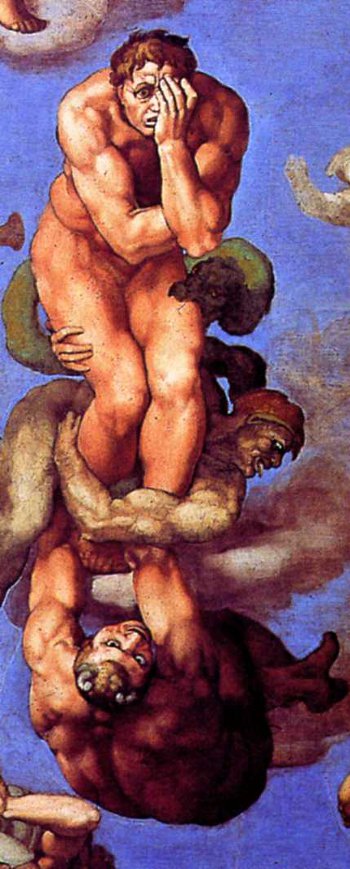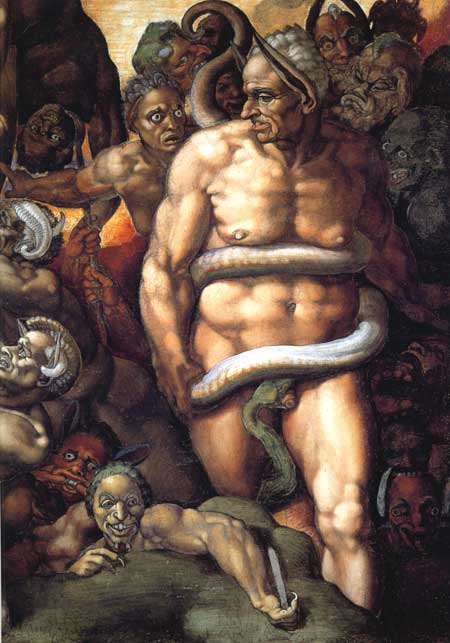Satan Was a Methodist
Satan was a Methodist
when I was child six days a week
and Jesus’ on Sundays.
Sermons were the hell
with which Frank Herson
blistered heaven Irish black
and scalded faint believers,
here for their weekly dose of hellfire
and deliverance,
cooking god his Sunday dinner
on this stained glass stove,
to be shared among the sinners.
In the furnace that the preacher stoked
the devil would be well at home.
He saved us from the fire below
by firing up the earth so hot
the heat of it scorched heaven.
Where there’s eternal light
there must be eternal heat.
Sweating sinners close as armpits
straight and hard as galley oarsmen
set to row to heaven
come collection and Amen.
Onward Christian Sailors
To the right and to the left
silent sinners coughing softly
sniffling in their Sunday hankies,
taking hell like wafers
and sweating blood.
Heavy hymnals tabled on their knees,
crackling starch and singing louder
as if god were deaf as well as mute,
standing up at halftime,
squeezing voices into song,
taking on the endless verses
printed where the music ends
trading volume for relief.
Singing like they’re pressing bladders
hoping heaven has a pot.
Ready for salvation
in the vacuum when the organ stops,
they settle into humble prayer
meekly suffering benediction,
biting off a cough
and moaning love on cue.
I was scared they’d take me with them
where I didn’t really want to go,
but he made me worry Sundays.
Did I really want to stay behind
and wait for Satan
to come and pull me under?
I wondered if I didn’t go to hell
would He come and get me
for playing with my meat
by beating on my soul?
Is it as bad to spend a lifetime fearing hell
as suffering in the wrong heaven?

I was yet too young to ponder
Satan, Metaphor.

The Last Judgment [details] -- Michaelangelo
The Cappella Sistina ("Sacellum Sixtinum" in Latin) is a chapel in the Apostolic Palace, the official residence of the pope, in Vatican City, the independent papal nation within Roma. Primarily it serves as the chapel of the Pontificalis Aula (papal court, now called the Cappella Pontificia, "Papal Chapel"), which comprised about 200 people, including clerics, Vatican officials, and distinguished laity; it is also the site of the papal conclave which selects new popes. The chapel, named after pope Sixtus IV, was designed by Baccio Pontelli and built under the supervision of Giovannino de Dolci between 1473 and 1481.The first stage in its decoration was the painting of the ceiling in blue, studded with gilt stars, with decorative borders around the architectural details of the pendentives. In 1480 Sixtus commissioned frescos (in which the paint is applied to damp plaster) for the side walls; the central tier featured two cycles of paintings, the lives of Moses and Jesus, offset by papal portraits above and trompe l’oeil drapery below; apparently they were supervised by Pietro Perugino; then, perhaps as part of a reconciliation between the pope and Lorenzo de' Medici, the de facto ruler of Florence, leading Florentine painters Domenico Ghirlandaio, Sandro Botticelli, and Cosimo Roselli began working on the project in 1481. The frescoes were finished in 1482. In 1506 Julius II began rebuilding the most potent symbol of the source of papal power, St. Peter's Basilica, and conceived a program to repaint the Sistine Chapel ceiling. Between 1508-12 the work was done by Michelangelo di Lodovico Buonarroti Simoni, a sculptor in his early 30s who had just completed his statue of David, which was supposed to represent Florentine freedom, and which a team of consultants, including Botticelli and Leonardo da Vinci, decided was too important to have it placed on the gable of the cathedral as originally intended and installed instead in the Piazza della Signoria, in front of the Palazzo Vecchio. Michaelango (who had been an apprentice of Domenico Ghirlandaio, one of the most competent and prolific of Florentine fresco painters) was reluctant to accept the papal commission, aince he was ambitious to further extend his reputation as a sculptor (and was already engaged on a commission for the pope's tomb) and was suspicious that such a large-scale project was being offered to him by his artistic enemies to set him up for an inevitable fall, but he finally accepted on condition that he have complete control over the content. However, a war between the papacy and France broke out, and Michaelangelo fled from Roma. In 1508 the pope returned victoriously to Roma and summoned Michelangelo to begin work on the ceiling; the tomb sculptures were never completed. The original commission was to paint Jesus' apostles on the large triangular pendentives which support the vault; but Michelangelo painted a series of nine pictures showing God's creation of the world and and mankind's fall from God's grace; around the upper parts of the windows he depicted the ancestors of Jesus, and on the pendentives he painted 12 Biblical and classical figures who had prophesied Jesus' role as mankind's savior.
ReplyDeleteIt took him four years to complete the 343 figures. At first, the plaster was too wet and developed a mold, forcing him to remove it and start over using a new formula created by one of his assistants, Jacopo l'Indaco. The, instead of following the usual practice of transferring a full-sized detailed drawing (a cartoon) onto the plaster, Michaelangelodrew directly onto the ceiling. First he applied broad areas of color, then, as the surface dried, he revisited these areas with a more linear approach, adding shade and detail with a variety of brushes. For some textured surfaces, such as facial hair and woodgrain, he used a broad brush with bristles as sparse as a comb. The final narrative scene, the famous depiction of God in the act of creation, was painted in a single day. To reach the ceiling, he designed a flat wooden platform on brackets built out from holes in the wall near the top of the windows; only half the building was scaffolded at a time, and the platform was moved as the painting proceeded in stages. The ceiling was supposed to be reworked with gold leaf and blue lapis lazuli in order to better link the ceiling with the walls, which were highlighted with a great deal of gold, but Michelangelo was reluctant to set up the scaffolding again, and probably also because the gold and the intense blue would have distracted from his painterly conception. Though he did not do the painting lying on his back, , "The work," according to the major chronicler of Renaissnce painting, Giorgio Vasari, "was carried out in extremely uncomfortable conditions, from his having to work with his head tilted upwards." Michelango wrote a poem to commemorate his experience:
ReplyDeleteI've grown a goitre by dwelling in this den–
As cats from stagnant streams in Lombardy,
Or in what other land they hap to be–
Which drives the belly close beneath the chin:
My beard turns up to heaven; my nape falls in,
Fixed on my spine: my breast-bone visibly
Grows like a harp: a rich embroidery
Bedews my face from brush-drops thick and thin.
My loins into my paunch like levers grind:
My buttock like a crupper bears my weight;
My feet unguided wander to and fro;
In front my skin grows loose and long; behind,
By bending it becomes more taut and strait;
Crosswise I strain me like a Syrian bow:
Whence false and quaint, I know,
Must be the fruit of squinting brain and eye;
For ill can aim the gun that bends awry.
Come then, Giovanni, try
To succour my dead pictures and my fame;
Since foul I fare and painting is my shame.
In 1515, Leo X commissioned "Raphael" (Raffaello Sanzio da Urbino) to design a series of 10 tapestries to hang around the lower tier of the walls, depicting events from the lives of Sts. Peter and Paul, the founders of the Christian Church in Roma. Due to their large size, the hangings took four years for the weavers in Pieter van Aelst's shop in Brussels to complete. (They were looted during the Sack of Rome in 1527 by the mutinous troops of Holy Roman emperor Charles V and most were burnt for their precious metal content.) Some two decades after the ceiling was painted, Clement II decided to add a resurrection mural on the chapel's altar wall, but his successor, Paul III, decided the Last Judgment ("Il Giudizio Universale") would be more relevant. Once again, the commission was offered to Michelangelo. He prepared the wall in 1535 and did the paintings between 1536 and 1541; in the process, he obliterated several of the popes, two sets of Jesus' ancestors, and the nativity of Jesus and the finding of Moses from the 1480s. One of his critics, the papal master of ceremonies Biagio da Cesena complained that it was better suited to "the public baths and taverns" because "it was mostly disgraceful that in so sacred a place there should have been depicted all those nude figures, exposing themselves so shamefully. Michelangelo responded by painting the cardinal's face onto Minos, one of the three judges of the underworld, giving him donkey ears and having a sepent biting on his genitals. When Cesena complained to Paul II, the pontiff claimed the portrait would have to rmain since papal jurisdiction did not extend to Hell. Nvertheless, after Michaelango's deathin 1564 one of his former pupils, Daniele da Volterra was hired to paint drapery over the genitalia in the fresco, for which he acquired the nickname "Il Braghettone" (the breeches maker). Other cover-ups were added over the next two centuries. When the chapel was restored late n the 20th century, all of the additions were removed except for those by Il Braghettone.
ReplyDelete